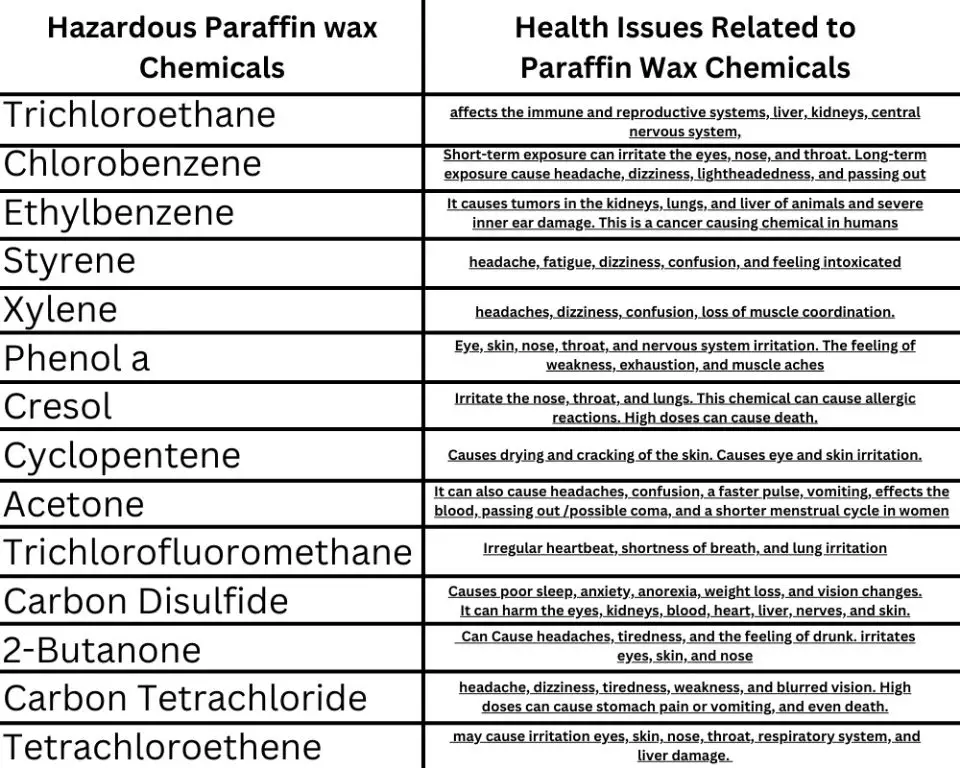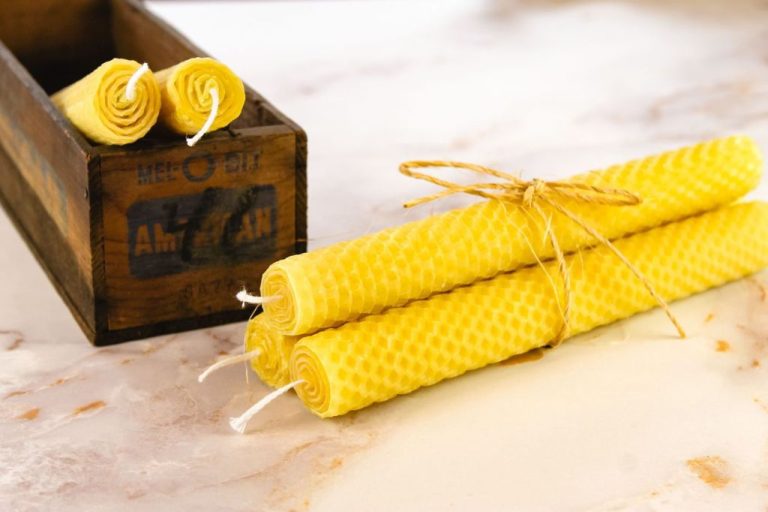What Chemicals Are In Paraffin?
What is Paraffin?
Paraffin wax, also known as paraffin, is a soft colorless or white solid derived from petroleum, coal, or oil shale. It consists of a mixture of hydrocarbon molecules containing between 20 and 40 carbon atoms.
Paraffin wax is derived from the residue left after crude oil has been refined into gasoline and other products. It is extracted using solvents and then purified.
Paraffin has a number of common uses:
- It is used in candle making to create candles that burn longer and brighter.
- In skincare, paraffin wax is used in paraffin baths and treatments to moisturize and soften skin.
- It is used to coat food containers and seal jams and jellies.
- Paraffin is also used in wax blends for making art, such as oil pastels and encaustic painting.
- It helps lubricate industrial equipment and is used as an electrical insulator.
Chemical Composition
Paraffin wax is composed mainly of straight-chain alkanes, saturated hydrocarbons with the general chemical formula CnH2n+2.
According to Britannica.com, the molecules in paraffin wax typically contain between 20 and 40 carbon atoms per molecule [1]. This makes them medium-chain alkanes. The various molecules present differ in their number of carbon atoms and properties.
The exact chemical composition can vary. Most paraffin waxes are derived from petroleum-based sources. The hydrocarbon mixture obtained from crude oil contains compounds with different carbon numbers based on the refining process. Paraffin with fewer carbon atoms (C18-C20) is found in high abundance in petroleum waxes. Microcrystalline wax contains some molecules with over 70 carbon atoms.
The melting point of paraffin wax increases with the average carbon chain length. Fully-refined paraffin waxes suitable for candles have melting points between 46–68°C.
Toxicity
Although paraffin wax itself is not acutely toxic, the chemicals used in its production can make it toxic to humans. According to Malibu Apothecary, paraffin wax often contains known carcinogens like benzene and toluene. When paraffin candles are burned, these chemicals are released into the air. Long term inhalation of the toxins released can lead to headaches, nosebleeds, asthma attacks, and an increased cancer risk.

The fragrance oils added to paraffin candles may also contain phthalates, which have been linked to hormone disruption and reproductive issues, according to Happy Wax. In addition, paraffin wax produces more soot than natural wax alternatives when burned, leading to increased indoor air pollution.
While more research is still needed, many health-conscious consumers are moving towards more natural candle wax options like soy, beeswax, and coconut wax to avoid the potential toxins found in paraffin.
Allergies
Some people may experience allergic reactions to certain ingredients in paraffin products. The most common allergic reactions are to dyes and fragrances that are sometimes added to paraffins.
According to sources (https://www.mountsinai.org/health-library/poison/paraffin-poisoning), if the paraffin contains a dye, a person who has an allergy to that dye may develop tongue and throat swelling, wheezing, and trouble breathing. Other potential allergy symptoms include skin redness, itching, hives, and irritation where the paraffin comes in contact with the skin.
Allergic reactions can range from mild to severe. In rare cases, anaphylaxis may occur which requires immediate medical care. If any signs of a serious allergic reaction appear after using a paraffin product, seek emergency medical help right away (https://www.advanced-dermatology.com.au/liquid-paraffin).
Carcinogens
Paraffin wax is derived from petroleum and may contain carcinogenic chemicals like benzene and toluene. When paraffin candles are burned, these chemicals are released into the air. According to research from Stanford University, burning a paraffin candle releases 11 different toluene-related chemicals like benzene, toluene, and styrene [1]. These chemicals are known carcinogens and can increase the risk of cancer.
A 2007 study found that burning paraffin-based candles can produce indoor air concentrations of benzene that exceed limits set by regulatory agencies. The researchers concluded that there is an “urgent need” for further research into the possible health effects of candle emissions [2]. However, some studies have found no conclusive evidence that paraffin wax itself causes cancer [3]. More research is still needed on the long-term health effects of burning paraffin candles.
Fragrance
The fragrance in paraffin wax candles comes from added fragrance oils, both natural and synthetic. Natural fragrances are derived from plant sources like essential oils, while synthetic fragrances are created in a lab. There has been some concern over potential health effects from fragrance oils, especially synthetics.
Synthetic fragrances may contain chemicals like phthalates and benzene derivatives that can disrupt hormones and potentially cause issues like asthma, allergies, and headaches in sensitive individuals. Natural fragrances are generally less problematic but can still trigger reactions in some. Overall, fragrance oils allow the custom scents people expect from candles, but some may prefer fragrance-free for health reasons.
According to The Flaming Candle, fragrance loads between 3-4% are typical in paraffin wax candles, though higher amounts are possible with additives. Most manufacturers recommend following safe usage guidelines and testing for skin sensitivities.
Dyes
Various dyes are commonly added to paraffin wax to produce candles in different colors. The most common types of dyes used in candle making include:
Liquid dye – This is a concentrated liquid that comes in many colors. A small amount is added to melted wax to achieve the desired hue. Liquid dyes work well in soy, paraffin, and other waxes.[1]
Dye blocks – These concentrated dye chips or blocks can be melted directly into wax. Dye blocks allow for deeper, more vibrant colors and are useful when dyeing large batches of wax. They work well in both soy and paraffin waxes.[2]
Powdered dye – Fine powdered dye can be sprinkled directly into melted wax. Produces muted, pastel colors. Mainly used with paraffin.
There are some safety concerns around dyes. Certain artificial dye pigments may release toxic fumes when burned. Some people may have skin sensitivities or allergies to certain dyes. When working with dyes, proper handling and ventilation is important. Natural, non-toxic dye alternatives made from fruits, vegetables, and minerals are available.
Regulations
The FDA regulates the use of paraffin and synthetic paraffins in food, cosmetics, and medical devices. According to FDA regulations, synthetic paraffin may be safely used as a coating or component in coatings on food packaging materials (FDA 175.250). The FDA has also established specifications for the use of petroleum wax, a type of paraffin wax, as a glazing or surface finishing agent on foods (FDA 172.886).
The FDA requires warning labels on certain cosmetic products containing paraffin to alert consumers about possible skin irritation or allergic reactions. Products containing paraffin must include warnings such as: “Warning – This product contains an ingredient that may cause skin irritation to certain individuals and a preliminary test according to accompanying directions should first be made. This product must not be used for diaper rash” (FDA 349.14).
Alternatives
There are some natural alternatives to paraffin wax that are gaining popularity, such as beeswax, soy wax, and other plant-based waxes. Here are some of the pros and cons of these alternatives:
Beeswax is a natural wax created by honey bees that has been used for centuries. Some pros of beeswax are that it is renewable, biodegradable, has a pleasant honey scent, and produces less soot when burned. However, beeswax is more expensive than paraffin and has a low melting point which can impact performance in some applications. It also has more allergens present than some plant-based waxes.
Soy wax is made from hydrogenated soybean oil. It is renewable, biodegradable, burns cleanly, and is usually less expensive than beeswax. Soy wax also blends well with other waxes. The drawbacks are that it does not retain scents or colors as well as paraffin or beeswax. It also solidifies more quickly which can make working with it trickier.
Other plant-based waxes like palm wax, bayberry wax, and candelilla wax are also alternatives to paraffin. They have similar benefits to soy wax but may be more niche, harder to source, or more expensive. Testing different natural wax blends is often needed to match the performance characteristics of paraffin wax.
Overall, natural waxes are renewable, sustainable alternatives but may need some formulation adjustments depending on the specific application and performance requirements. Cost is also usually higher compared to petroleum-based paraffin wax.
Summary
In summary, paraffin wax is composed primarily of straight chain alkanes, ranging from C20 to C40 in chain length. The most common alkanes found are octacosane, hexatriacontane, pentatriacontane, and tetracosane. While paraffin wax is considered relatively nontoxic, some key takeaways for consumers are:
- Paraffin wax can contain carcinogenic impurities like benzene and toluene if not properly purified.
- The fragrance chemicals added to paraffin wax can also be allergens or irritants for some people.
- Inhalation of paraffin wax fumes should be avoided as it may cause lipid pneumonia.
- Paraffin wax is not allowed to come into contact with food in the United States, Canada, and the European Union.
- Natural wax alternatives like soy wax and beeswax may be safer options for candles and cosmetics.
Overall, while paraffin wax itself is relatively inert, consumers should be aware of potential contaminants and proper usage precautions when using products containing it.




